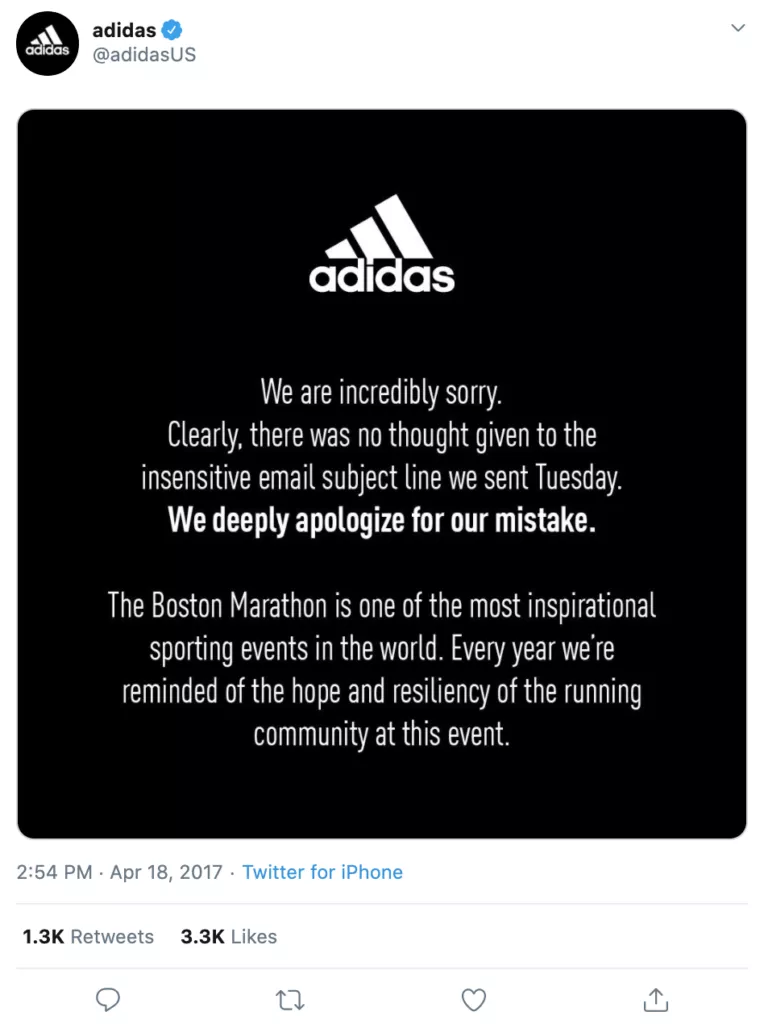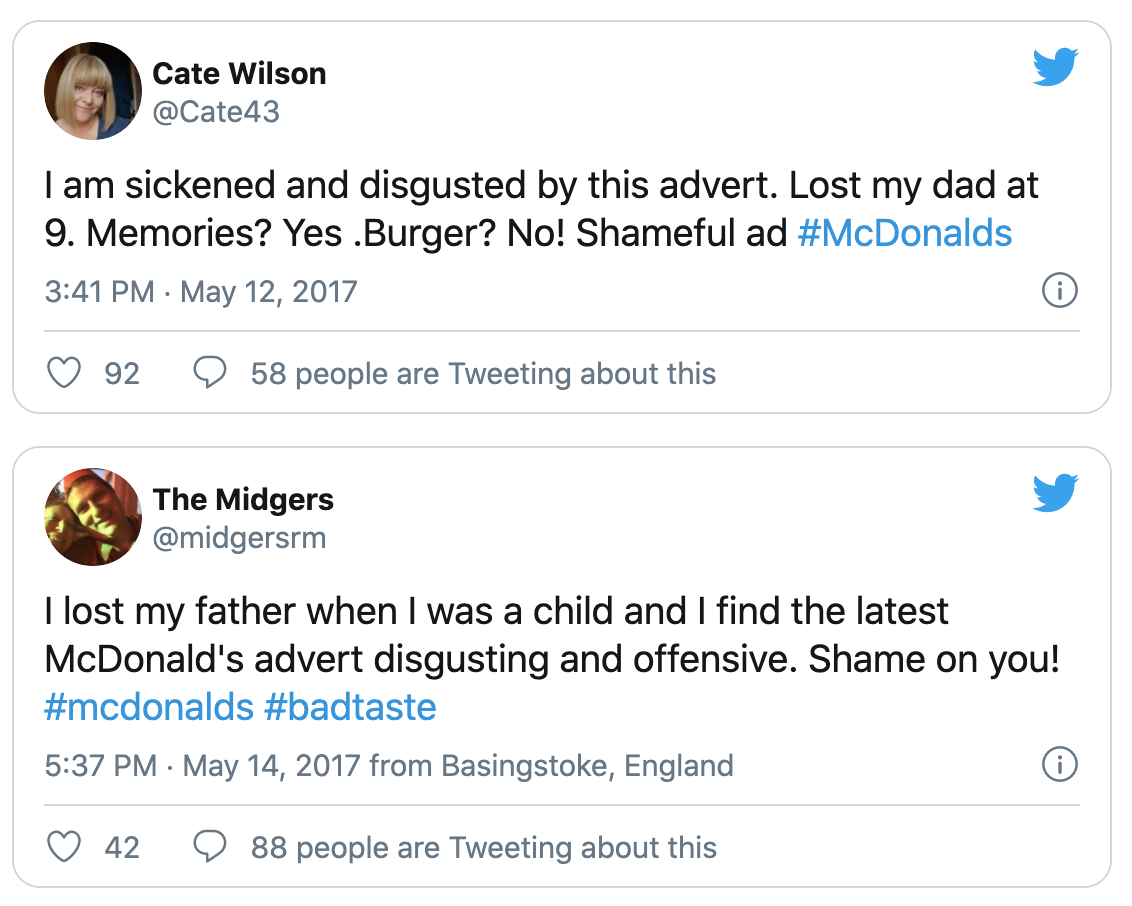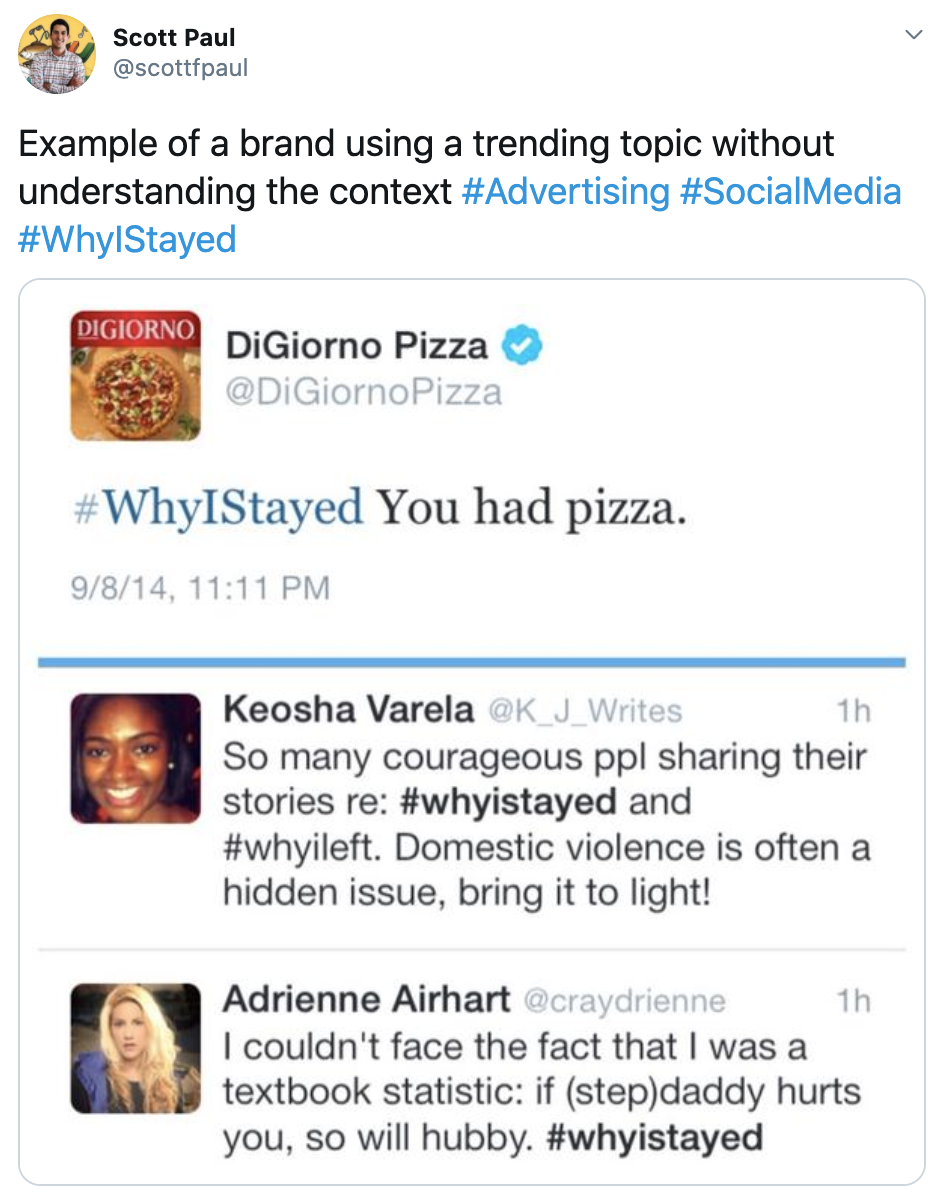7 Crippling Big Brand Marketing Mistakes You Can Avoid

We all make mistakes.
Even big-name companies like Coca Cola and McDonald’s do
But normalizing making mistakes is not a winning mindset. Especially when you’re looking to scale your business.
You see, mistakes are good opportunities for growth.
We need to make them in order to improve and adapt.
BUT….
If you want to become a better version of yourself and build a stronger business, you need to learn from your mistakes AND from the mistakes of other businesses.
That’s why today, I’m going to share with you:
- The top 7 marketing mistakes big companies like Apple, Adidas, and McDonald’s have made (so that you don’t make them too!).
- A few key takeaways from each marketing mistake that you can use to help your business avoid serious pitfalls.
- And several proven strategies for making sure your marketing is on-point and doesn’t alienate your target audience.
So ready to see this mistake made by the brand so many people in the world love?...
In a rush? Want to download this article as a PDF so you can easily take action on it later? Click here to download this article as a PDF guide.

Marketing Mistake #1: Apple’s Heavy Handed “Gift” That No One Could Refuse

Apple is one of the biggest names in tech.
And in the past decade, it’s really tried to expand its reach into other areas like entertainment production, payment processing, and licensing.
It’s entrance onto the music scene has been particularly successful.
However, Apple’s love of music clashed with its customers when the trillion-dollar company forced the new U2 album “The Edge” onto more than 500 million devices.

The act was meant to be a promotional stunt. “Hey!” Apple was saying. “Here’s a free gift from us, on the house.”
The problem, however, was that not everyone wanted the new U2 album pushed onto their phones.
And worse yet, the album was also difficult to delete. Some companies even developed ways to hack into the system just to get Bono and The Edge out of the damn library.
As a result, the reaction to the stunt was largely negative—a disappointment since the deal reportedly cost Apple at least $100 million according to the New York Times.
What Can You Learn from This Marketing Mistake?
First off, don’t force anything onto your customers.
That should be obvious.
But if you dig a little deeper, there’s also another lesson to learn from this example.
And that’s the value of A/B testing.
A/B testing is the absolute best way to test the viability of a marketing hypothesis.
If, for example, Apple had A/B tested their idea, they probably would have found that most of their customers didn’t want to be forced to have the new U2 album in their iTunes library.
And if you aren’t A/B testing your marketing, then you run the risk of making a serious marketing mistake (hopefully not as costly as $100 million though).
Marketing Mistake Example #2: Coca Cola’s Failed Attempt at Reinventing the Wheel (i.e., “New Coke”)

No article on marketing mistakes would be complete without mentioning Coke’s famous (or infamous) attempt at releasing a fresh new take on their much beloved product.
New Coke (the mention alone may still be enough to elicit shudders in some of you) was released on April 23rd, 1985.
It was a sweeter reformulation of the classic, launched mostly to compete with their biggest rival, Pepsi.
TIME’s’ food critic Mimi Sheraton described the flavor like this:
“New Coke seems to retain the essential character of the original version… However, it is sweeter than the original formula and also has a body that could best be described as lighter. It tastes a little like classic Coca-Cola that has been diluted by melting ice.”
Mmmm, diluted Coca Cola...
And while New Coke was more sugary than the original (which you’d think many people would love), it turns out that New Coke was hated by the majority of those who tried it.
The product was such a flop that it was removed from the production line a mere 3 months after launch.
When all was said and done, Coca Cola spent a reported $4 million on research and marketing New Coke and lost about $30 million in unsold inventory.
Yeesh.
What Can You Learn from This Marketing Mistake?
Now, there’s obviously a lesson to learn here about A/B testing. I mean, how could a company as massive and experienced as Coca Cola not know ahead of time that this was a bad idea?
But since we already looked at A/B testing with Apple, there’s another takeaway here that’s worth discussing…
Don’t fix what ain’t broken.
If you have a flagship product that’s killing it with your target customer, don’t you dare take it off your production line.
You can diversify the products and services you offer, of course.
And in fact, people love having multiple choices when it comes to finding what’s right for them. That’s the Law of Range at work.
But just because you’re offering more options doesn’t mean you have to replace the old ones.
In fact, if you do have a great product that’s bringing in amazing numbers, you may want to double down on it too.
And if you are going to risk the farm by changing your core product on a fundamental level, you’d better be prepared for the consequences...
Marketing Mistake #3: Adidas Overlooked a Major Marketing Mistake In Light of Current Events

On April 15th, 2013, two bombs went off during the Boston Marathon.
3 people were killed and hundreds of others were injured.
It was a tragedy.
Now, in times of major current events, big-name brands need to be extra careful about the messages they’re sending.
One example of a company that did not do this after the Boston Marathon bombings was Adidas.
Soon after the disaster, those who subscribed to the company’s email list received an email with the following subject line…

Now of course, this was a mistake. And Adidas was quick to send out an apology email soon after they realized what had happened (see the email above the congrats one).
They also sent out a heartfelt apology tweet too.

And since it was an honest mistake and Adidas was so quick to heartfully apologize, most people ended up forgiving them (it got 3.3K likes after all).
What Can You Learn From This Marketing Mistake?
There are 2 main takeaways from the Adidas blunder.
1. Audit Your Marketing After Big Events – Major events call for major audits of your marketing messaging. Are there any words or phrases that, in light of what just happened, may come off tone deaf or offensive? If so, try to remove it as fast as possible. If it’s too late, be transparent and call it out, even if only a few people have noticed. That way, you can control the narrative and apologize before the massive backlash.
2. Authenticity Is Key – If you do end up offending your audience accidentally, be sure that you apologize in an authentic, meaningful way. Authentic marketing is not just a way to help your business stand out. It’s also a way to remind your audience that your business is made up of real people, just like them.
Marketing Mistake #4: McDonald’s UK Commercial Tests the Waters of Child Bereavement

It’s important that the biggest international brands try to connect with their audience on an emotional level.
Why?
Because emotion oftentimes drives action. And studies have shown that emotional memories tend to stick in our mind more than neutral ones.
Now, most marketers know this. It’s why we included emotion as one of the 11 Laws of Sales Funnel Physics.
But when the way you’re trying to elicit emotion seems a bit off, it can actually cause backlash instead of buying.
Case and point, this McDonald’s UK ad.

For those that would rather read than watch, the commercial follows a young boy asking his mother about what his father was like before he died.
As she lists off his qualities, the boy becomes increasingly sad because it seems the two didn’t have much in common.
That is until he sits down to eat a McDonald’s Filet-O-Fish.
With a smile, the mother says, “That was your dad’s favorite too.”
Cut to the son, wide eyed.
After this ad aired, many people shouted that it was exploitative of child bereavement.
Outrage rose. Cancel culture calls abounded. Grief centers and the Advertising Standards Authority were flooded with complaints.
Offended parties also took to social media…

And within 1 week, McDonald’s removed the ad.
What Can You Learn from This Marketing Mistake?
Despite the value of using emotion to influence your target market, doing it tactfully is walking a fine line.
See, the problem with the McDonald’s ad isn’t that it was done poorly. It isn’t that it didn’t hit the right emotional cues (I actually found it kind of sweet). And it isn’t that it was unrelatable.
The problem is that an experience as monumentally life shattering as losing a parent should not be evoked in the service of a $1.25 Filet-O-Fish (or any other unrelated product).
A sandwich, no matter how tasty it is, shouldn’t be put alongside something as big, as formative, and as heart-wrenching as bereavement because the two have far different levels of gravity to them.
The problem gets down to alignment or making sure your product and marketing meets the expectations of your audience (another of the 11 Laws of Sales Funnel Physics).
If you’re trying to reach out to families who have lost a loved one, a Big Mac won’t help them with their grief.
See how that works?
So make sure you employ emotion carefully and wisely in your marketing. And above all, make sure that the type of emotion you’re trying to bring out matches well with your product or service.
Marketing Mistake #5: GAP’s Flip-Flop Logo Flub
This one’s a quickie, but it’s important.
Since 1986, GAP has had one of the most iconic logos in the clothing industry.
But for a quick stint in 2010, the company made a short lived rebranding effort.
Check it out below.

To put it lightly, fans of the brand were less than enthused.
Okay, they were pissed.
All in all, the rebranding effort and failure cost GAP a reported $100 million.
Yikes.
What Can You Learn from This Marketing Mistake?
Now, there are 2 lessons here.
First, great design is incredibly important to your branding.
Whether you’re creating a new lead magnet to bring in high-quality prospects or trying to make sure your website’s look is unique and attractive, design definitely counts.
So don’t skimp on hiring a great designer for your business (by the way designers, we’re hiring!).
And second (like Coke), don’t fix what ain’t broken.
GAP’s logo was a success for decades. And over the years, they’d built up a hefty fanbase that loved it.
Switching it out so quickly (and with something so drastically different) alienated lots of loyal fans.
So when it comes to your business, find what works and stick with it. And if you do decide to change, try going with small changes first, like those outlined in our Proven Sales Conversion Pack.
Marketing Mistake #6: DiGiorno’s “What Were You Thinking” Tweet

Back in 2014, there were a series of hashtags that were trending on Twitter.
They were “#WhyIStayed” and “#WhyILeft.”
The goals here were to help reduce the stigma around talking about domestic abuse and encourage current victims to get the help they needed.
People would tweet what kept them from leaving their abusive partners and what finally got them to pick up and leave.
Now, it’s not unusual for brands to try piggybacking off of trending topics. But DiGiorno did so in a spectacularly terrible way.
Check out their tweet below.

*Shudders*
Of course, DiGiorno was quick to send out an apology tweet after the backlash…

But by then, the damage was done and Twitter was alight.
What Can You Learn from This Marketing Mistake?
So, what’s the lesson here?
Well, the most immediate problem is that DiGiorno was using language it didn’t entirely understand.
Obviously they weren’t trying to say that their pizza is so good, it can outweigh the hell of living in an abusive relationship. That’s just crazy.
So in that sense, you should always be sure you fully understand any worldwide event before deciding to have your brand comment on it.
But the bigger picture problem here is a lack of understanding of the audience.
See, DiGiorno simply didn’t put in the time to learn more about who the audience for that hashtag was.
If they would have done that, they would have quickly realized that this wasn’t just some meaningless phrase to stamp on any old message. Instead, it had deep emotional resonance and a very specific meaning to tens of thousands of people.
So if there’s one overarching lesson here, it’s that no matter what type of marketing project you’re creating (whether it’s a landing page, lead magnet, or newsletter), it needs to be built on a strong foundation of understanding your core audience.
Because the more you understand them, the better able you’ll be to speak to their problem and show why your offering is the right solution.
Marketing Mistake #7: McDonald’s (Again)—But This Time, It’s About Their Special Sauce

If you’re not a fan, Rick and Morty is a cartoon for adults.
And since its start back in 2013, its popularity has exploded.
Now, the much-awaited premiere of season 3 featured one of the characters (Rick) revealing that his primary motivation for his entire life, including inventing a dimension shifting portal gun, is to taste something called Szechuan Sauce.
This sauce was released by McDonald’s for a limited time to help promote Disney’s Mulan back in 1998.
Well, after a swell of support from Rick and Morty fans, McDonald’s decided to re-release the sauce for an incredibly short window of time… just one day.
Why not try to capitalize on the surge in interest, right?
Well it turns out, McDonald’s severely underestimated the demand the sauce was going to generate. And they simply could not produce enough Szechuan Sauce to meet that demand.
People were outraged.
Crowds in the thousands chanting “We want sauce!” had to be held back by police…

Others went to great lengths to get the sauce only to be disappointed…

And McDonald’s, after surveying the destruction, both apologized and agreed to add more Szechuan Sauce to their menu for more locations around the country.

What Can You Learn from This Marketing Mistake?
The lesson here is pretty obvious… give us more Szechuan Sauce!
Just kidding.
McDonald’s main failing was that it didn’t properly estimate the demand for their promotion.
And the lesson here is that if you are going to offer a deal (a discount, a free trial, a bonus resource—whatever), you need to be sure your business can actually accommodate that deal.
Make sure you have the right staffing set up to absorb a surge in work requests.
Make sure you have systems in place to keep things efficient, even when you’re flooded with orders.
And make sure that your business’ mouth is only writing checks that its butt can cash.
Because if you don’t, and your popularity explodes, it can actually end up doing more harm than good if you can’t keep up.
Conclusion
Download the “7 Biggest Marketing Mistakes You Have to See to Believe” so you won’t forget to take action on it later. Click here to download it now.
So there you have it!
These are the 7 biggest marketing mistakes I’ve seen from some of the most well-known brands in the world.
I hope that this article has helped you understand that yes, even billion-dollar companies aren’t perfect.
And on top of that, if you take the time to study these mistakes, you can actually avoid them in the future.
To review, here are some of the core takeaways from this article to help your business keep on growing:
- Always A/B test your marketing efforts to know if people will actually respond to it or if launching it full-scale will turn into a PR disaster.
- Be careful about taking a stance on an issue. But if you do, be prepared for the consequences and do it in an authentic, compassionate way.
- Always audit your marketing messaging after big events (like national tragedies). And if you make a mistake in your messaging, be authentic with your apology.
- Make sure your marketing messaging is aligned with your audience. And use emotion to a degree that’s proper for your product (e.g., not Filet-O-Fishes with child bereavement).
- Don’t skimp on great design and don’t fix what ain’t broken with your marketing!
- Always take extra time to understand your audience and especially the language they’re using (i.e., don’t be like DiGiorno’s).
- Be sure that your business can actually handle any influxes caused by discounts, coupons, or new deals. Otherwise, you may piss off more people than you please.
Now, which of these mistakes has your business been guilty of in the past? Has this article helped you catch any that you were on the verge of making yourself? And what other major marketing mistakes have you seen big brands make in the past?
Let me know in the comments below.
Keep Growin’, stay focused,














